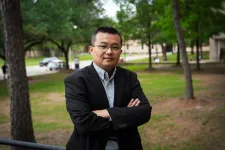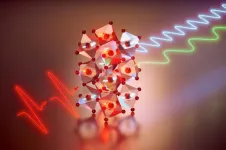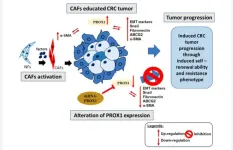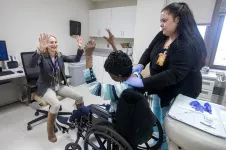(Press-News.org) The U.S. Department of Defense (DoD) awarded a $5 million grant to the University of Texas Rio Grande Valley (UTRGV)-led America’s Additive Foundry Consortium, which includes the University of Houston as a key partner. This is one of six grants – totaling about $30 million – to help enhance national security through community investments.
The funding will enable the consortium to undertake a $7.5 million project designed to ensure that the U.S. military has a stable supply of domestically produced, high-quality tactical alloys critical for national defense. The consortium will accomplish this by focusing on developing novel advanced manufacturing methods.
UH, located in the Energy Capital of the World, has a special advantage to contribute. Ben Xu, assistant professor of mechanical engineering and Presidential Frontier Faculty Fellow at UH, will serve as the site director of the Houston-based Demonstration Hub for the consortium. The demonstration hub will link small and medium-sized manufacturers to DoD contractors, showcase various advanced manufacturing processes, provide local technical support to facilitate commercialization and implementation of the proposed novel technologies and help upskill and reskill existing workforce.
“Securing the supply of specialty alloys and maintaining the ability to conduct forging and casting operations are essential to producing military equipment,” Xu said. “We [the consortium] will develop and demonstrate alternative casting and forging processes by leveraging metal additive/hybrid/convergent manufacturing technologies to modernize America’s foundry operations in the Texas Coastal Plains region through advanced research, technical support, business development, and workforce training with a focus on small manufacturers.”
The consortium has an ambitious agenda. During the five-year grant period, the consortium aims to demonstrate additive casting and hybrid forging processes to 1,800 manufacturers, incubate 45 startups and pitch 30 companies. In addition, it will leverage resources of partner institutions to provide relevant workforce training and educational programs.
Other key consortium partners include the UTRGV Center for Advanced Manufacturing Innovation and Cyber Systems, UT Austin, UT San Antonio, Georgia Tech, Texas Manufacturing Assistant Center, Army Research Laboratory, America Makes, Advanced Robotics for Manufacturing, and Tooling U-SME.
This initiative is expected to benefit the TX-SGCP region, which includes Brownsville-Harlingen, McAllen-Edinburg-Mission, Corpus Christi, Houston-The Woodlands-Sugar Land, San Antonio-New Braunfels, and Greater Austin.
“Businesses and the workforce, now and in the future, need to be really knowledgeable about advances in technology – not only for optimal efficiency, but also to adapt to changing scenarios and innovate new solutions to stay competitive and secure,” said Ramanan Krishnamoorti, vice president for energy and innovation at UH. “This will benefit not only them but also the region and the nation. We have a great opportunity to revitalize American manufacturing through collaboration to foster research, innovation, and workforce development.”
END
University of Houston researcher part of $5 million DOD grant to support defense manufacturing
UH key partner in America’s Additive Foundry Consortium
2024-02-07
ELSE PRESS RELEASES FROM THIS DATE:
Researchers measure and control interactions between magnetic ripples using lasers
2024-02-07
One vision for the future of computing involves using ripples in magnetic fields — called magnons — as a basic mechanism. In this application, magnons would be comparable to electricity as the basis for electronics.
In conventional digital technologies, such magnonic systems are expected to be far faster than today’s technologies, from laptops and smartphones to telecommunications. In quantum computing, the advantages of magnonics could include not only quicker speeds but also more stable devices.
A recent study in the journal Nature Physics reports an early-stage discovery along the path ...
Africa could grow more rice -- new study shows how
2024-02-07
Africa’s rice sector has major opportunities to increase its yield gains through improved agronomic practices while avoiding massive land conversion, a study by international scientists including a Husker co-investigator finds. The production advances can be important in meeting Africa’s projected food needs and reducing dependence on imports, the researchers concluded.
Rice demand in Africa is projected to more than double over the next 25 years due to population growth and increased rice consumption. At present, Africa imports nearly 40% of its rice.
“Nearly 15 million hectares of rice are waiting for yield improvement in Africa, ...
PROX1/α-SMA correlated with colorectal cancer progression, poor outcomes and therapeutic resistance
2024-02-07
“The findings validate the combined PROX1/α-SMA gene set as a prospective prognostic biomarker and a central regulator in CRC progression and its TME.”
BUFFALO, NY- February 7, 2024 – A new research paper was published in Aging (listed by MEDLINE/PubMed as "Aging (Albany NY)" and "Aging-US" by Web of Science) Volume 16, Issue 2, entitled, “PROX1 interaction with α-SMA-rich cancer-associated fibroblasts facilitates colorectal cancer progression and correlates with poor clinical outcomes and therapeutic resistance.”
The tumor microenvironment (TME) plays a vital role in tumor progression through intricate ...
Ancient rocks improve understanding of tectonic activity between earthquakes
2024-02-07
UNIVERSITY PARK, Pa. — Rocks once buried deep in ancient subduction zones — where tectonic plates collide — could help scientists make better predictions of how these zones behave during the years between major earthquakes, according to a research team from Penn State and Brown University.
Clues from rock formations in Alaska and Japan allowed the scientists to develop a new model to predict the pressure solution activity in subduction zones, the researchers reported in the journal Science Advances. ...
The Medical University of South Carolina will be one of four sites exploring the genetic basis of Parkinson’s disease in the Black community
2024-02-07
The Michael J. Fox Foundation for Parkinson’s Research has chosen MUSC as one of four sites for the Black and African American Connections to Parkinson’s Disease (BLAAC PD) research study, a part of the Global Parkinson’s Genetics Program.
BLAAC PD will explore the genetic basis of Parkinson’s disease (PD) in the Black community by genotyping more than 150,000 people worldwide, setting the stage for the development of targeted treatments. According to the Parkinson’s Foundation, approximately 36,265 people with ...
ORNL's Jason DeGraw named ASHRAE Fellow
2024-02-07
The American Society of Heating, Refrigeration and Air-Conditioning Engineers, or ASHRAE, selected Jason DeGraw, a researcher with the Department of Energy’s Oak Ridge National Laboratory, as one of 23 members elevated to Fellow during its 2024 winter conference.
A thermal-fluid scientist and mechanical engineer in the Thermal Energy Storage group, DeGraw was recognized for making substantial contributions in heating, ventilation, air-conditioning and refrigeration, and the built environment. He contributes education, research, engineering design and consultation, publications, presentations and mentoring to ASHRAE. At ORNL, DeGraw works with the Building Technologies ...
Sara Federico, MD, named director of the Solid Tumor Division at St. Jude Children’s Research Hospital
2024-02-07
(Memphis, Tenn. – February 7, 2024) St. Jude Children’s Research Hospital today announced Sara M. Federico, MD, has been named director of the institution’s Solid Tumor Division within the Department of Oncology. Federico is an internationally recognized leader in pediatric oncology whose contributions have defined the landscape of treatment for high-risk childhood solid tumors, such as neuroblastoma.
“Dr. Federico’s experience will pave the way for new discoveries that will help advance cure rates for patients with high-risk cancers by identifying, testing and optimizing novel therapeutic strategies,” said Julie R. ...
Cancer researcher Craig B. Thompson named 2024 Watanabe Prize winner
2024-02-07
INDIANAPOLIS – Pioneering cancer researcher Craig B. Thompson, MD, has been named the 2024 winner of the August M. Watanabe Prize in Translational Research.
Awarded by the Indiana University School of Medicine, the Watanabe Prize is one of the nation's largest and most prestigious awards recognizing individuals focused on shepherding scientific discoveries into new therapies for patients. The prize is awarded to a senior investigator who has made a significant contribution to the field of translational science.
Thompson is the former president and chief executive officer ...
Chapman scientists code ChatGPT to design new medicine
2024-02-07
Generative artificial intelligence platforms, from ChatGPT to Midjourney, grabbed headlines in 2023. But GenAI can do more than create collaged images and help write emails — it can also design new drugs to treat disease.
Today, scientists use advanced technology to design new synthetic drug compounds with the right properties and characteristics, also known as “de novo drug design.” However, current methods can be labor-, time-, and cost-intensive.
Inspired by ChatGPT’s popularity and wondering if this approach could speed up the drug design process, scientists in the Schmid ...
Erectile dysfunction drugs may be linked to reduced risk of Alzheimer’s disease
2024-02-07
EMBARGOED FOR RELEASE UNTIL 4 P.M. ET, WEDNESDAY, FEBRUARY 7, 2024
MINNEAPOLIS – The drugs used to treat erectile dysfunction may also be associated with a reduced risk of Alzheimer’s disease, according to a study published in the February 7, 2024, online issue of Neurology®, the medical journal of the American Academy of Neurology. The study does not prove that erectile dysfunction drugs reduce the risk of Alzheimer’s disease. It only shows an association.
Erectile dysfunction drugs, which work by dilating blood vessels to allow more blood ...
LAST 30 PRESS RELEASES:
Numbers in our sights affect how we perceive space
SIMJ announces global collaborative book project in commemoration of its 75th anniversary
Air pollution exposure and birth weight
Obstructive sleep apnea risk and mental health conditions among older adults
How talking slows eye movements behind the wheel
The Ceramic Society of Japan’s Oxoate Ceramics Research Association launches new international book project
Heart-brain connection: international study reveals the role of the vagus nerve in keeping the heart young
Researchers identify Rb1 as a predictive biomarker for a new therapeutic strategy in some breast cancers
Survey reveals ethical gaps slowing AI adoption in pediatric surgery
Stimulant ADHD medications work differently than thought
AI overestimates how smart people are, according to HSE economists
HSE researchers create genome-wide map of quadruplexes
Scientists boost cell "powerhouses" to burn more calories
Automatic label checking: The missing step in making reliable medical AI
Low daily alcohol intake linked to 50% heightened mouth cancer risk in India
American Meteorological Society announces Rick Spinrad as 2026 President-Elect
Biomass-based carbon capture spotlighted in newly released global climate webinar recording
Illuminating invisible nano pollutants: advanced bioimaging tracks the full journey of emerging nanoscale contaminants in living systems
How does age affect recovery from spinal cord injury?
Novel AI tool offers prognosis for patients with head and neck cancer
Fathers’ microplastic exposure tied to their children’s metabolic problems
Research validates laboratory model for studying high-grade serous ovarian cancer
SIR 2026 delivers transformative breakthroughs in minimally invasive medicine to improve patient care
Stem Cell Reports most downloaded papers of 2025 highlight the breadth and impact of stem cell research
Oxford-led study estimates NHS spends around 3% of its primary and secondary care budget on the health impacts of heat and cold in England
A researcher’s long quest leads to a smart composite breakthrough
Urban wild bees act as “microbial sensors” of city health.
New study finds where you live affects recovery after a hip fracture
Forecasting the impact of fully automated vehicle adoption on US road traffic injuries
Alcohol-related hospitalizations from 2016 to 2022
[Press-News.org] University of Houston researcher part of $5 million DOD grant to support defense manufacturingUH key partner in America’s Additive Foundry Consortium










